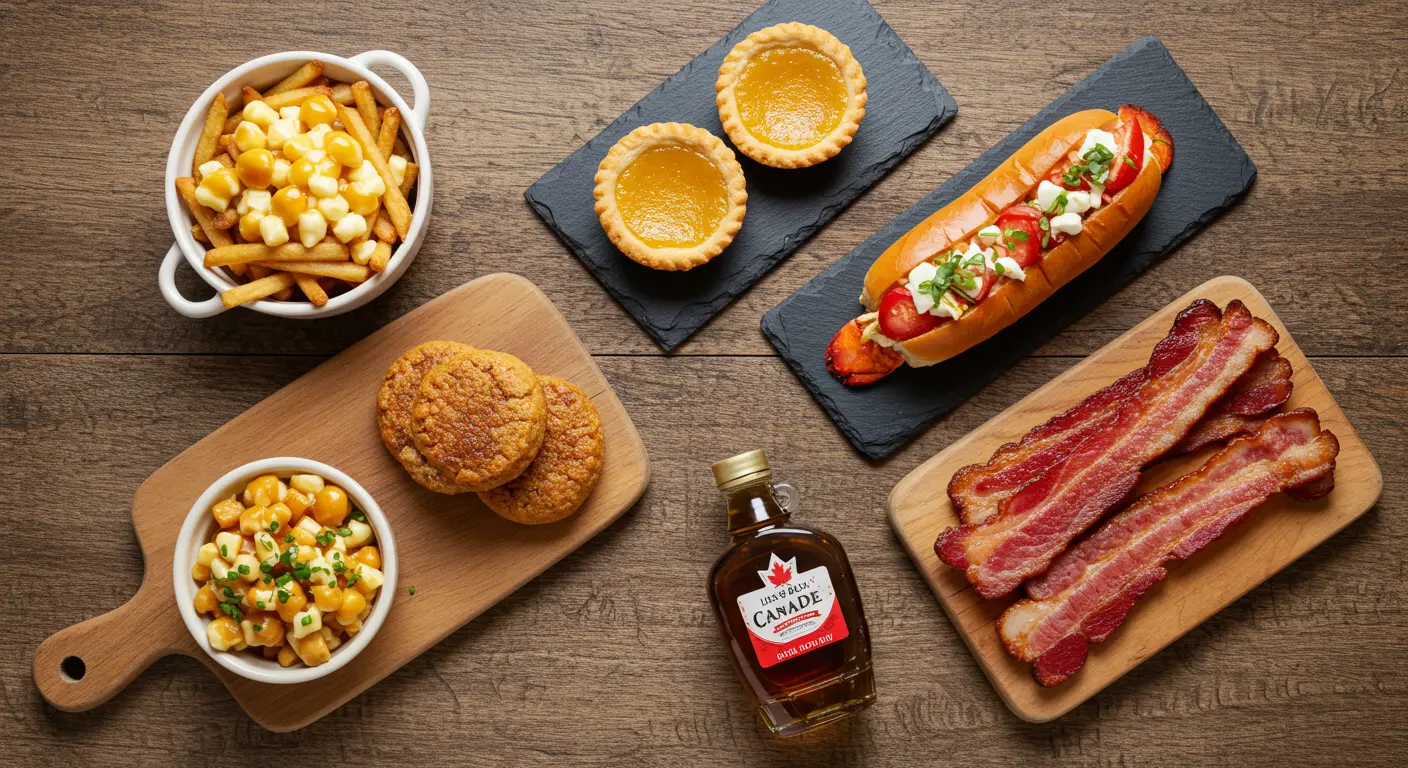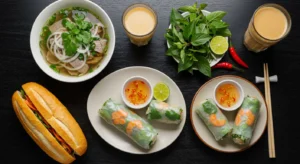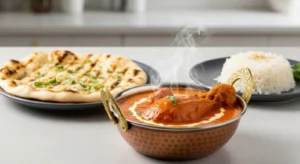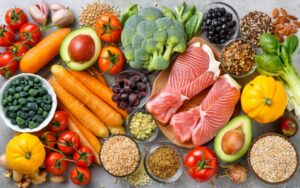Table of Contents
A Beginner’s Guide to the Flavourful World of Canada’s Food
Picture this: you’re standing on a pier in Nova Scotia, the salty Atlantic air filling your lungs. A friendly local hands you a plate of freshly shucked Malpeque oysters, their briny taste like a direct sip of the ocean. Now, fast forward a few days. You’re in Quebec City, wrapped in a cozy scarf, biting into a steaming, gravy-smothered poutine that warms you from the inside out.
These aren’t just meals; they’re postcards from a place. And when it comes to Canada, the postcards are deliciously diverse.
If you think Canadian cuisine begins and ends with maple syrup, you’re in for a treat. Canada’s food story is a fascinating tapestry woven from its indigenous roots, its French and British heritage, and a modern, vibrant mosaic of global influences. It’s a story of survival, celebration, and incredible local ingredients. So, whether you’re planning a trip or just curious from your kitchen, let’s dive into the rich, hearty, and surprisingly varied world of food in Canada.
More Than Maple: The Foundations of Canadian Cuisine
To understand Canada’s food, you have to start with the land itself. This is a country defined by its geography—the world’s longest coastline, vast boreal forests, sprawling prairies, and the harsh, beautiful Arctic. This environment has directly shaped what’s on the plate for centuries.
Indigenous culinary traditions are the true bedrock. For thousands of years, First Nations, Inuit, and Métis peoples developed a deep, respectful relationship with the local flora and fauna. Think of dishes like bannock, a simple, versatile fry-bread; pemmican, a high-energy mix of dried meat, fat, and berries that was essential for survival; and the use of ingredients like wild game (caribou, bison), fish (salmon, trout), and foraged foods like wild rice and berries. This connection to the land is experiencing a powerful revival today, led by Indigenous chefs who are reclaiming and celebrating these ancestral foods.
Then came the settlers. The French brought their techniques and flavours, evident in tourtières (meat pies) and rich stews. The British contributed their love of pies, fish and chips, and hearty pub fare. As immigrants arrived from across Europe and, later, the globe, they brought their culinary traditions, which slowly adapted to the ingredients available in their new home. The result? A uniquely Canadian culinary identity that’s always evolving.
A Coast-to-Coast Culinary Road Trip
The best way to grasp the scale of Canada’s food scene is to take a virtual road trip. The regional differences are stark and incredibly exciting.
The Atlantic Provinces: Where the Ocean is the Pantry
In Newfoundland, Nova Scotia, Prince Edward Island, and New Brunswick, the sea is the star. You haven’t lived until you’ve tried:
- Lobster Rolls: Sweet, tender lobster meat lightly dressed and stuffed into a toasted, buttered bun. It’s summer on a plate.
- Digby Scallops: Plump, succulent scallops from the Bay of Fundy, often seared to perfection.
- Jiggs’ Dinner: A classic Newfoundland Sunday meal featuring salt beef boiled with vegetables like cabbage, carrot, and potato, served with pease pudding and gravy. It’s the definition of comfort food.
Quebec: A Taste of Europe in North America
Quebec’s French heart beats strongly in its cuisine. The province is a food destination in its own right.
- Poutine: Let’s get the big one out of the way. The holy trinity of crispy fries, fresh cheese curds (that must squeak when you bite them!), and hot brown gravy is a national icon. Don’t knock it ‘til you try it.
- Tourtière: A spiced meat pie, traditionally made with pork, veal, or game, that’s a centrepiece of holiday celebrations, especially Réveillon (Christmas Eve).
- Montreal-style Bagels: Smaller, denser, and sweeter than their New York cousins, these bagels are boiled in honey-sweetened water and baked in wood-fired ovens. The debate over which city makes the better bagel is a friendly, cross-border rivalry.
Ontario & The Prairies: Heartland Harvest
This is Canada’s agricultural engine room. Ontario’s Niagara Peninsula is famous for its tender fruits and wines, while the Prairie provinces of Manitoba, Saskatchewan, and Alberta are the nation’s breadbasket.
- Peameal Bacon: Also called “Canadian bacon” elsewhere, the true Toronto version is lean, cured pork loin rolled in cornmeal. It’s a must-try in a breakfast sandwich.
- Pierogi: Thanks to strong Ukrainian communities, these delicious dumplings (often filled with potato, cheese, or sauerkraut) are a staple.
- Alberta Beef: Renowned worldwide for its quality and flavour, thanks to the province’s ideal cattle-ranching conditions. A perfectly grilled Alberta steak is a thing of beauty.
The West Coast: A Pacific Northwest Paradise
British Columbia is all about fresh, local, and innovative. The “100-Mile Diet” concept was born here for a reason.
- Pacific Salmon: Whether it’s sockeye, coho, or chinook, wild BC salmon is a cornerstone. It can be grilled, cedar-planked, or smoked.
- Spot Prawns: A short but celebrated season in spring brings foodies out for these sweet, delicate prawns.
- Asian Fusion: With a huge Asian influence, particularly in Vancouver, the food scene is incredible. You’ll find some of the best Chinese, Japanese, and Vietnamese food outside of Asia.
The North: Arctic Bounty
In the Yukon, Northwest Territories, and Nunavut, the cuisine is shaped by a harsh climate and rich indigenous traditions.
- Game Meats: Caribou, muskox, and Arctic char are dietary staples, prepared in ways that have sustained communities for generations.
- Bannock: This simple bread is a versatile companion to meals across the North.
Canada’s Food Today: A Modern Mosaic
Walk down any main street in Toronto, Vancouver, or Montreal, and you’ll see a reflection of the world. This multiculturalism is the single biggest influence on contemporary Canadian cuisine. You can find authentic Ethiopian injera, Sri Lankan hoppers, Vietnamese pho, and Italian pasta, often on the same block.
This isn’t just about restaurants; it’s about fusion. Modern Canadian chefs are brilliantly blending these global techniques with local ingredients. Imagine a dish featuring Ontario duck breast with a cherry gastrique made from BC cherries, or a poutine topped with butter chicken. It’s this creative, boundary-pushing spirit that makes the current food scene so thrilling.
For a deeper dive into the ingredients that define this modern landscape, the Canadian Encyclopedia offers an excellent overview of the history of Canadian cuisine, which is a fantastic resource for understanding the context behind the food.
Ready to Taste Canada? Your Starter Guide.
Feeling hungry? Here’s how you can start exploring.
- Visit a Farmers’ Market: This is the quickest way to connect with local producers. You’ll taste the difference in a sun-warmed Ontario peach or a just-picked Quebec strawberry.
- Be Seasonally Aware: Canadians celebrate the short growing season with gusto. Don’t miss maple syrup in the spring, sweet corn and berries in the summer, and apples and squash in the fall.
- Don’t Be Shy: Ask locals for their recommendations. The best food is often found in unassuming, family-run spots.
Frequently Asked Questions About Canada’s Food
Q: Is Canadian food just poutine and maple syrup?
A: Not at all! While those are two famous icons, the reality is much more complex and delicious. Canada’s food includes incredible seafood, world-class produce, unique game meats, and a vast array of dishes influenced by its multicultural population.
Q: What is a classic Canadian dessert?
A: Besides maple syrup on everything, you have to try Butter Tarts (a gooey, sweet tart often with raisins or pecans) and Nanaimo Bars (a no-bake dessert bar with a crumb base, custard icing, and chocolate topping).
Q: Is food expensive in Canada?
A: It can be, especially in major cities and remote areas. However, eating like a local—seeking out markets, ethnic grocery stores, and casual diners—can be very affordable. The high quality of ingredients often justifies the price.
Q: What’s the best way to experience Canadian food?
A: Travel across the country if you can! Each region has its own specialties. If you can’t travel, seek out Canadian restaurants in your area or try your hand at cooking classic recipes at home.
Q: Are there any unique Canadian drinks?
A: Absolutely. Canada is famous for its ice wines, a sweet dessert wine made from grapes frozen on the vine. Canadian whisky (often spelled ‘rye’ regardless of the grain) is also world-renowned. And of course, the Caesar—a cocktail made with clamato juice, vodka, hot sauce, and Worcestershire sauce—is a Canadian invention and a beloved brunch staple.
The Final Bite
Canada’s food is as vast and varied as the country itself. It’s a story that starts with the land and its original peoples and continues to be written by generations of newcomers. It’s hearty, innovative, and deeply connected to place. From the squeaky cheese curds in your poutine to the wild salmon on your cedar plank, every bite tells a story.




